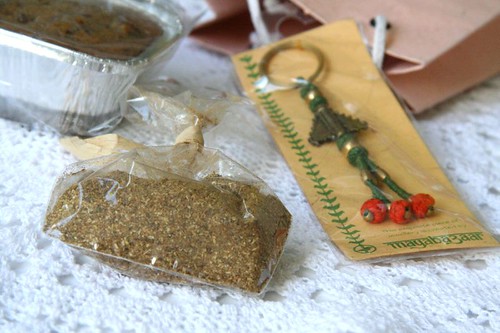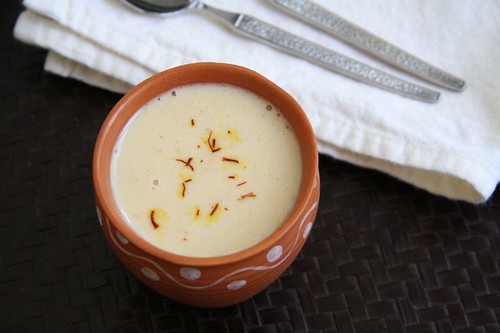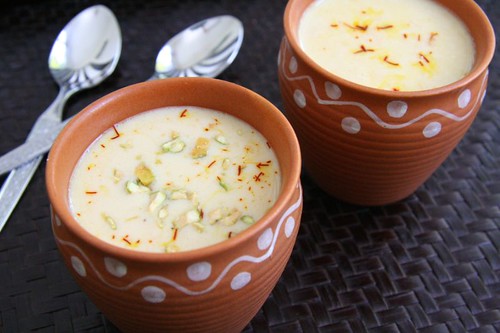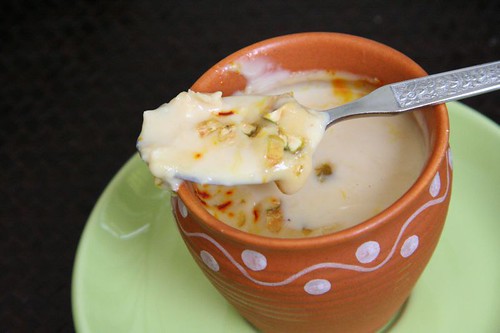with DALimbyAchA masAle bhAtThe arusuvai link came to me from
thecooker, a blogger whose posts always seem to be about just the kind of healthy and innovative, but playful and fuss free food that I like to eat. Naturally I was looking forward to what I would receive, and the contents of the package did not disappoint even one bit.
First, the obligatory photo of the goodies that arrived, taken in a hurry, left largely un-arranged. A nearly half gobbled date cake (no, it didn't come that way, it came whole), baked by the cooker, which was utterly delicious, a very pretty desi trinket, and of course the star, the masala in a packet.

The cooker kept things easy for me - no guessing games. She told me that the masala was called 'kaccha masala' (raw spices powder) that she had made using the recipe from the marathi cookbook '
Ruchira'. Now all this was well over two month ago. Umm, something like that. In the meanwhile, a gentle reminder came from her after what she must have thought a reasonable amount of time had passed, to check on whether I plan to post about it, and last week, she herself
posted about the masala too. I had told her that the reason I hadn't blogged about it was because the thing I wanted to make required much planning and I wasn't getting around to that, which only piqued her curiosity further.
Since she had given me the details, I had looked up Ruchira, which mentioned that the 'kaccha masala' is particularly good in dishes like khichadi, masale bhaat and rassa. I got (somewhat unrealistically) ambitious, and instead of the usual masaale bhaat which is made with any one vegetable like eggplant or tondli, I thought of making the birde bhaat, also called DALimbyAchA bhAt, made with sprouted and peeled kadwe vaal, which I might have made possibly once before, and is quite a delicacy to savor. Making the rice isn't particularly daunting, but the prospect of spending an hour just peeling the beans was what was preventing me from taking any action.
Finally, I bit the bullet and soaked the beans. There was no option for looking back after that. Within about two days the beans had sprouted and were ready to be peeled. With the Obama-Clinton drama unfolding in the background, I spent a couple of hours, peeling these. Yes, it does take quite that long, and even longer with my unskilled fingers, hence my earlier procrastination which I had to get over.
Once the beans are peeled, and with the masala on hand, making the rice is as simple as, well, making rice. I adapted the recipe for 'dalimbyacha bhaat' from
Ruchira, but since I was using 'kaccha masala', I added it to the oil first, letting the spices saute a bit before adding the rice. As I made the rice, the aroma that wafted was unmistakably that of a maharashtrian wedding hall, as described rather well by
the cooker in her post. And since the masale bhaat is such a fixture at weddings and other occasions, that it is the highest compliment that can be paid to the masala. This masala is definitely a great one to use for getting just the 'right' taste of masale bhaat.
The arusuvai now travels over to Manisha of
Indian Food Rocks.
 Top L-R: dried beans, sprouted beans
Top L-R: dried beans, sprouted beans
Bottom L-R: peeled beans, finished rice dish
Dalimbyacha bhaatServe this rice as part of any festive meal, or by itself for a treat.
Ingredients1 cup basmati rice
1 cup sprouted and peeled kadwe vaal / Dalimbyaa / surti vaal
3-4 Tablespoons + 1 teaspoon oil
1/2 teaspoon mustard seeds
pinch of asafoetida (hing)
1/2-3/4 teaspoon turmeric
a few curry leaves
2 teaspoons
kaccha masala1/2-1 teaspoon chili powder
salt to taste
handful of cashews
1 Tablespoon crumbled jaggery
1/2 cup of coconut (or adjust to taste)
5-8 Tablespoons of chopped cilantro
ghee for serving
MethodHeat the oil in a wide and deep saucepan or dutch oven. Add the mustard seeds, and when they start to pop, add the asafoetida, turmeric, curry leaves, and the kaccha masala. Reduce heat, stir for a few seconds, and add the rice and the sprouted vaal. Stir everything together for about a minute, add 3-4 cups of water, and bring it to a boil. Add salt and chili powder, reduce the heat, and let cook until just a little water remains. At this point, add the jaggery, and stir once. Reduce the heat to very low, and cover the pan for 10-15, until the rice absorbs all the water. In the meanwhile, heat a teaspoon of oil in a small skillet and saute a handful of cashews in it until they turn golden brown. Add the cashews, coconut, and cilantro to the rice, reserving a little for garnishing. Drizzle a little ghee over the rice while serving.
 Variations
VariationsInstead of using sprouted and peeled vaal, one can use the skinned and split dried val, by soaking it for a few hours before use. The flavor and texture is not quite the same as the sprouted ones, but comes close.
Instead of using beans, one can also use a chopped vegetable like eggplant or tondli, or shelled green peas, for an equally delicious and much less labor intensive rice dish.


































